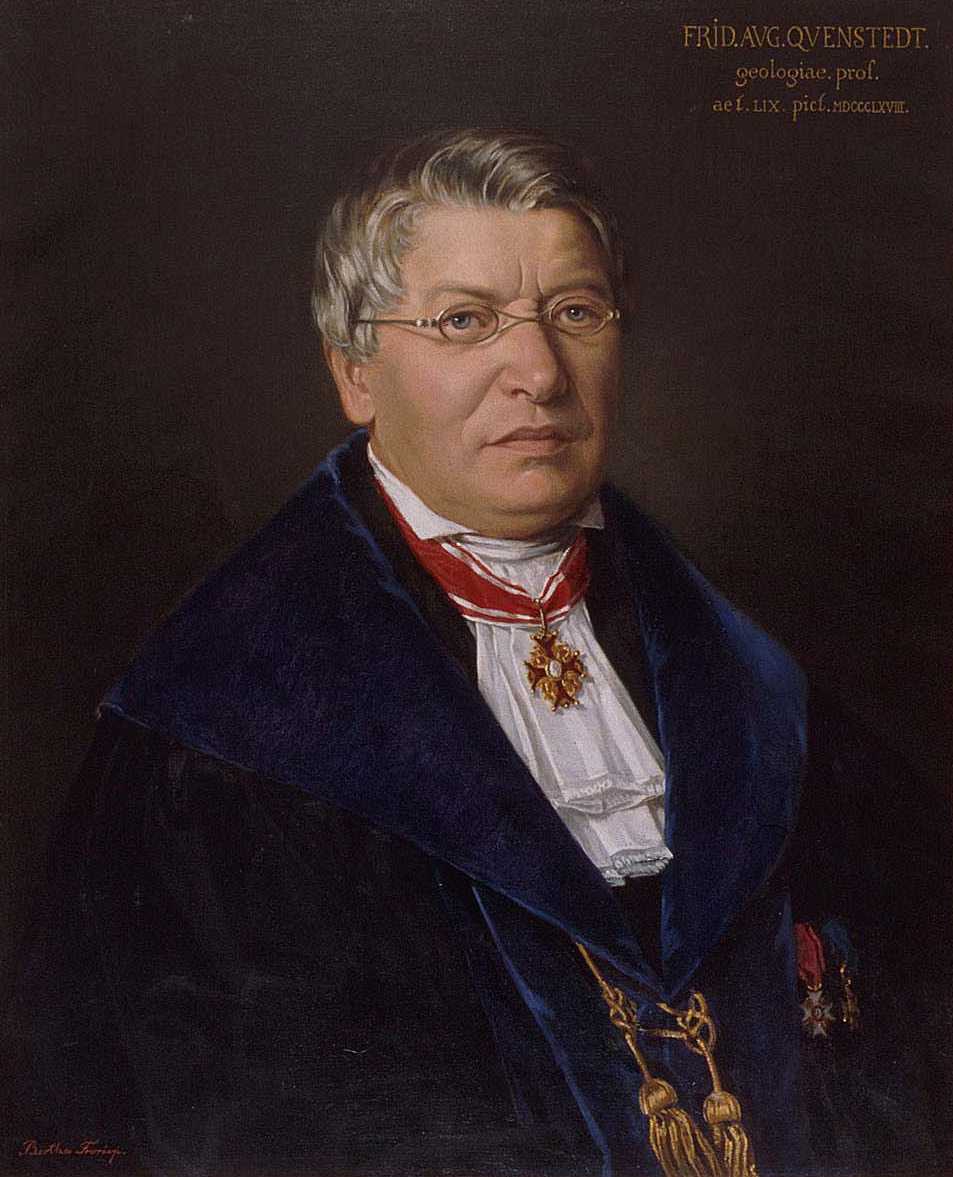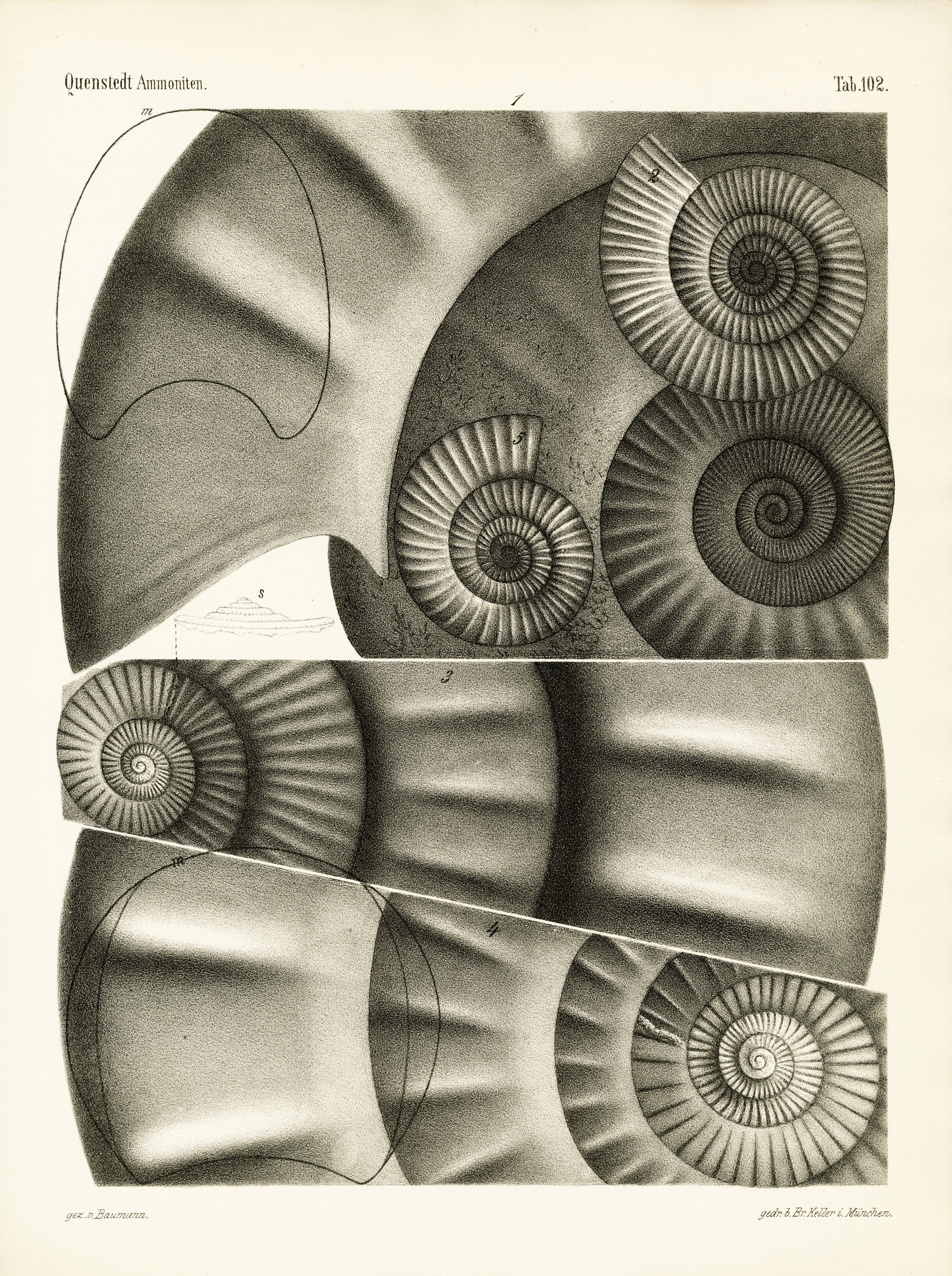Friedrich August Von Quenstedt on:
[Wikipedia]
[Google]
[Amazon]
 Friedrich August von Quenstedt (July 10, 1809 – December 21, 1889), was a German
Friedrich August von Quenstedt (July 10, 1809 – December 21, 1889), was a German
Rheinische-Geschichte.lvr.de, Retrieved 9 November 2015
 His chief publications were:
*''Method der Krystallographie'' (1840)
*''Das Flözgebirge Wurttembergs'' (1843)
*''Petrefactenkunde Deutschlands'' (7 vols. and atlases, 1846–84)
*''Die Cephalopoden'' (1846–49)
*''Handbuch der Petrefactenkunde'' (2 vols., 1852, 2nd ed. 1867, 3rd ed. 1882-85)
*''Der Jura'' (2 vols, 1858)
*''Handbuch der Mineralogie'' (1855, 3rd ed. 1877)
*''Die Ammoniten des Schwäbischen Jura'' (1883–84).
His chief publications were:
*''Method der Krystallographie'' (1840)
*''Das Flözgebirge Wurttembergs'' (1843)
*''Petrefactenkunde Deutschlands'' (7 vols. and atlases, 1846–84)
*''Die Cephalopoden'' (1846–49)
*''Handbuch der Petrefactenkunde'' (2 vols., 1852, 2nd ed. 1867, 3rd ed. 1882-85)
*''Der Jura'' (2 vols, 1858)
*''Handbuch der Mineralogie'' (1855, 3rd ed. 1877)
*''Die Ammoniten des Schwäbischen Jura'' (1883–84).
Chronophobia
Complete scanned plates from ''Die Ammoniten des Schwäbischen Jura'' {{DEFAULTSORT:Quenstedt, Friedrich August Von 1809 births 1889 deaths 19th-century German geologists German paleontologists
 Friedrich August von Quenstedt (July 10, 1809 – December 21, 1889), was a German
Friedrich August von Quenstedt (July 10, 1809 – December 21, 1889), was a German geologist
A geologist is a scientist who studies the solid, liquid, and gaseous matter that constitutes Earth and other terrestrial planets, as well as the processes that shape them. Geologists usually study geology, earth science, or geophysics, althoug ...
and palaeontologist
Paleontology (), also spelled palaeontology or palæontology, is the scientific study of life that existed prior to, and sometimes including, the start of the Holocene epoch (roughly 11,700 years before present). It includes the study of fossi ...
.
Life
Von Quenstedt was born atEisleben
Eisleben is a town in Saxony-Anhalt, Germany. It is famous as both the hometown of the influential theologian Martin Luther and the place where he died; hence, its official name is Lutherstadt Eisleben. First mentioned in the late 10th century, E ...
in Saxony
Saxony (german: Sachsen ; Upper Saxon: ''Saggsn''; hsb, Sakska), officially the Free State of Saxony (german: Freistaat Sachsen, links=no ; Upper Saxon: ''Freischdaad Saggsn''; hsb, Swobodny stat Sakska, links=no), is a landlocked state of ...
, and educated at the Humboldt University of Berlin
Humboldt-Universität zu Berlin (german: Humboldt-Universität zu Berlin, abbreviated HU Berlin) is a German public research university in the central borough of Mitte in Berlin. It was established by Frederick William III on the initiative ...
. After a period as assistant in the mineralogical museum, he was appointed associate professor (1837) and then professor (1841) of mineralogy and geognosy
Abraham Gottlob Werner (; 25 September 174930 June 1817) was a German geologist who set out an early theory about the stratification of the Earth's crust and propounded a history of the Earth that came to be known as Neptunism. While most tene ...
at the Eberhard Karls Universität Tübingen.
Work
His earlier work related chiefly to crystallography and mineralogy, on which subjects he published text-books that were widely used. However, he also became distinguished for his researches on palaeontology, and especially for those on thefossil
A fossil (from Classical Latin , ) is any preserved remains, impression, or trace of any once-living thing from a past geological age. Examples include bones, shells, exoskeletons, stone imprints of animals or microbes, objects preserved ...
s of the Jurassic
The Jurassic ( ) is a geologic period and stratigraphic system that spanned from the end of the Triassic Period million years ago (Mya) to the beginning of the Cretaceous Period, approximately Mya. The Jurassic constitutes the middle period of ...
system.
In 1845, he devised a trinomial system of nomenclature for Jurassic ammonites, which has caused some difficulty for later taxonomists.J.H. Callomon, D. T. Donovan, & M. K. Howarth "F. A. Quenstedt's Trinominal Nomenclature of Jurassic Ammonites" ''Palaeontology'' 47 (4) 1063 (2004) He investigated series of ammonite fossils which appeared to represent the coiled and uncoiled forms of similar shells, and considered that they arose as 'pathological' forms. He also wrote several articles on pterosaur
Pterosaurs (; from Greek ''pteron'' and ''sauros'', meaning "wing lizard") is an extinct clade of flying reptiles in the order, Pterosauria. They existed during most of the Mesozoic: from the Late Triassic to the end of the Cretaceous (228 ...
s.
Five genera were named in his honour: the bivalve mollusc genus ''Quenstedtia'' Morris & Lycett 1854 and the (homonymous) coelenterate genus ''Quenstedtia'' Rominger 1876, coelenterate genus ''Quenstedtiphyllia'' Melnikova 1975, ammonite genus ''Quenstedtoceras Hyatt'', 1876, and crinoid genus ''Quenstedticrinus'' Klikushin 1987. Also the specific epithet of ''Proganochelys quenstedti
''Proganochelys'' is an extinct, primitive stem-turtle that has been hypothesized to be the sister taxon to all other turtles creating a monophyletic group, the ''Casichelydia''. ''Proganochelys'' was named by Georg Baur in 1887 as the oldest tur ...
'' was named after him.
The mineral quenstedtite
Quenstedtite is an uncommon iron sulfate mineral with chemical formula Fe2(SO4)3·11H2O. It forms violet or white triclinic crystals. Found in oxidized zones of pyrite-rich orebodies, especially in arid climates. It was first reported in 1888 f ...
was named in his honour by G. Linck in 1888.
When Maria von Linden
Maria von Linden (18 July 1869 – 25 August 1936) was a German bacteriologist and zoologist. She became one of the first women in Germany to be given the academic title of “professor”. She patented a type of bandage and won a prize for he ...
wrote her first paper on the mineral deposits in the River Hürbe it was read at Karlsruhe's geological society (by a man) in 1890. The paper was noticed by Quenstedt who supported her ambitions. Linden went on to be the first woman in Germany to be called a professor.Maria von LindenRheinische-Geschichte.lvr.de, Retrieved 9 November 2015
Chief publications
 His chief publications were:
*''Method der Krystallographie'' (1840)
*''Das Flözgebirge Wurttembergs'' (1843)
*''Petrefactenkunde Deutschlands'' (7 vols. and atlases, 1846–84)
*''Die Cephalopoden'' (1846–49)
*''Handbuch der Petrefactenkunde'' (2 vols., 1852, 2nd ed. 1867, 3rd ed. 1882-85)
*''Der Jura'' (2 vols, 1858)
*''Handbuch der Mineralogie'' (1855, 3rd ed. 1877)
*''Die Ammoniten des Schwäbischen Jura'' (1883–84).
His chief publications were:
*''Method der Krystallographie'' (1840)
*''Das Flözgebirge Wurttembergs'' (1843)
*''Petrefactenkunde Deutschlands'' (7 vols. and atlases, 1846–84)
*''Die Cephalopoden'' (1846–49)
*''Handbuch der Petrefactenkunde'' (2 vols., 1852, 2nd ed. 1867, 3rd ed. 1882-85)
*''Der Jura'' (2 vols, 1858)
*''Handbuch der Mineralogie'' (1855, 3rd ed. 1877)
*''Die Ammoniten des Schwäbischen Jura'' (1883–84).
Notes
Other referencesObituary
by WT Blanford, ''Quart. Journ. Geol. Soc.'' vol. xlvi. pp. 51–52,1890.
External links
Chronophobia
Complete scanned plates from ''Die Ammoniten des Schwäbischen Jura'' {{DEFAULTSORT:Quenstedt, Friedrich August Von 1809 births 1889 deaths 19th-century German geologists German paleontologists